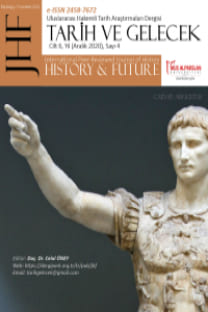Keşmir Çatışmasının Tarihsel Kodları
Historical Codes of the Kashmir Conflict
___
- Referans 1: Abdullah, Sheikh Mohammad, “India, Pakistan and Kashmir”, Foreign Affairs, Cilt 43, Sayı 3, 1965, 528-35.
- Referans 2: Adhikari, Suddepto ve Mukul Kamle, “The Kashmir: An Unresolved Dispute Between India and Pakistan”, Geopolitics Quarterly, Cilt 6, Sayı 4, 2010, 58-107.
- Referans 3: Bayur, Y. Hikmet, Hindistan Tarihi III. Cilt, Türk Tarih Kurumu Basımevi, Ankara, 1987.
- Referans 4: Bazaz, Prem Nath, The History of Struggle for Freedom in Kashmir: Cultural and Political, from the Earliest Times to the Present Day, Kashmir Publishing Company, New Delhi, 1954.
- Referans 5: Behera, Navnita Chadha, Demystifying Kashmir, Brookings Institution Press, Washington DC, 2006.
- Referans 6: Bose, Sumantra, Kashmir: Roots of Conflict, Paths to Peace, Harvard University Press, Cambridge, 2003.
- Referans 7: Copland, Ian, “Islam and Political Mobilization in Kashmir, 1931-34”, Pacific Affairs, Cilt 54, Sayı 2, 1981, 228-59.
- Referans 8: Guha, Ramachandra, “Opening a Window in Kashmir”, World Policy Journal, Cilt 21, Sayı 3, 2004, 79-94.
- Referans 9: Khan, Nyla Ali, Sheikh Mohammad Abdullah’s Reflections on Kashmir, Palgrave Macmillan, New York, 2018.
- Referans 10: Lamb, Alastair, Kashmir: A Disputed Legacy, 1846-1990, Roxford Books, Hertingfordbury, 1991.
- Referans 11: Mangrio, Naghma, “A Historical and Political Perspective of Kashmir Issue”, The Dialogue, Cilt 7, Sayı 3, 2012, 255-264.
- Referans 12: McCarthy, Michael R., A Subject of Dispute: A Legal Analysis of the Claims of India and Pakistan to Kashmir, Durham theses, Durham University, 2002.
- Referans 13: Schofield, Victoria, Kashmir in Conflict: India, Pakistan and the Unending War, I.B. Tauris, New York, 2003.
- Yayın Aralığı: Yılda 4 Sayı
- Başlangıç: 2015
- Yayıncı: Celal ÖNEY
SEKA Kağıt Müzesi'nde Bulunan Pişmiş Toprak Kandiller
1389 Kosova Savaşı ve Arnavutlar
Ortaçağda Mülkiyet ve Kişilik İhlalleri: Burcî Memlûk Sultanı Ferec b. Berkûk Örneği
Türk Gümrüğünde Sanayi Eksenli Muafiyetler (1929-1943)
Kosova Devletinin Temeli Olarak Bujan Konferansı
1989 Yılı Anayasal Değişiklikler ve Kosova’nın Ekonomik Açısına Yapılan Darbe
Anadolu’yu İlk İmar Edenler: Fethin Asıl Sahipleri
Demokrat Parti’nin “Atatürk Sevgisi” (1954) Belgesel Filmi
V.S. Naipaul’un Nehrin Dönemeci Adlı Eserinin Postkolonyal Analizi
